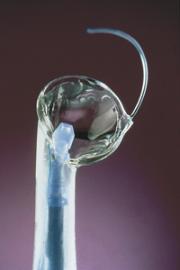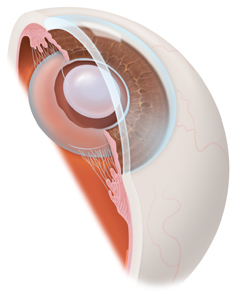An intraocular lens (IOL) is a tiny, lightweight, clear plastic or silicone disc placed in the eye during cataract surgery. An IOL replaces the focusing power of the eye’s natural lens.
Your eye’s natural lens plays an important role in focusing images on the retina. When a cataract develops, the lens loses its clarity. Light rays cannot focus clearly, and the image you see is blurry. Eyeglasses or contact lenses usually can correct slight refractive errors caused by early cataracts, but they cannot sharpen your vision if an advanced cataract is present.
The only treatment for a severe cataract is to remove the eye’s natural lens and replace it with an IOL. Intraocular lenses offer many advantages. Most commonly, a fixed focus foldable lens is used to provide optimum correction for distance vision. ‘Premiere’ IOLs are available to correct astigmatism (Toric IOLs), or to help minimize the dependency on glasses for both distance and reading (Multifocal or Accommodative IOLs.) Unlike contact lenses, which must be removed, cleaned, and reinserted, the IOL remains in the eye after surgery.



Aspheric lens implant (IOL)
Toric lens implant (IOL) to correct astigmatism
An IOL may be implanted either in front of or behind the iris. Behind the iris is the most frequent placement site. IOLs can be made of hard plastic, soft plastic, or soft silicone. Soft, foldable lenses can be inserted through a small incision, which shortens recovery time following surgery.
The rapid evolution of IOL designs, materials, and implant techniques has made them a safe and practical way to restore normal vision after cataract surgery.
(c) 2015, 2009 Robert M Schertzer, MD, MEd, FRCSC based on 2007 The American Academy of Ophthalmology
